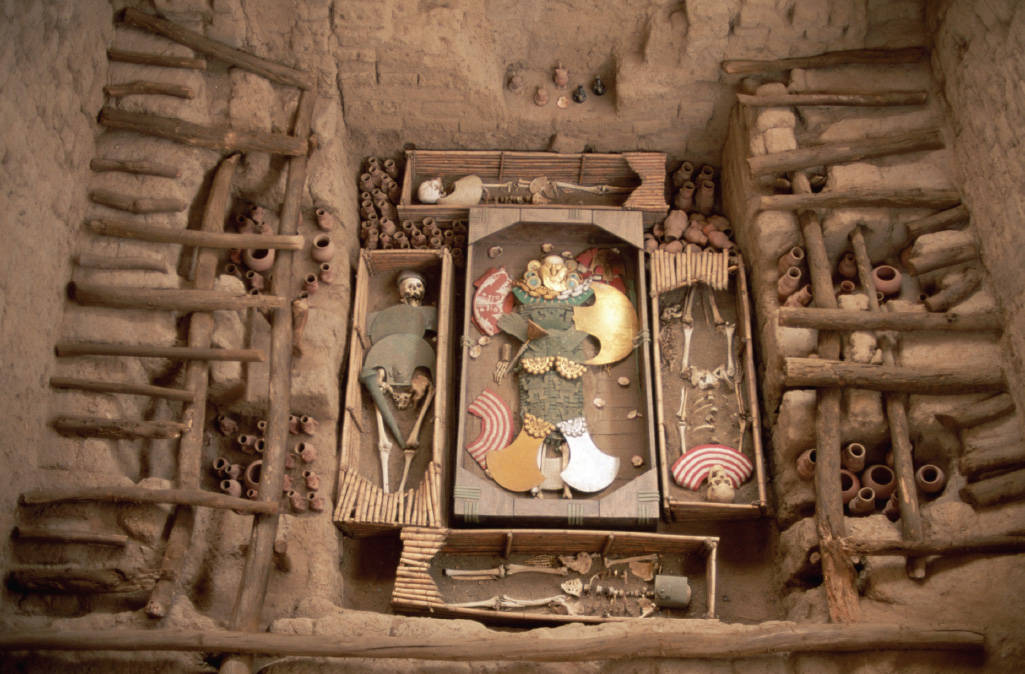Moche: A Civilization of the Coast
Description
Question
What features of Moche life characterize it as a civilization?
[Answer Question]
By 200 B.C.E., the pan-Andes Chavín cult had faded, replaced by a number of regional civilizations. Among them, Moche (MOH-chee) civilization clearly stands out. Dominating a 250-mile stretch of Peru’s northern coast and incorporating thirteen river valleys, the Moche people flourished between about 100 and 800 C.E. Their economy was rooted in a complex irrigation system, requiring constant maintenance, which funneled runoff from the Andes into fields of maize, beans, and squash and acres of cotton, all fertilized by rich bird droppings called guano. Moche fishermen also harvested millions of anchovies from the bountiful Pacific.
Politically, Moche was governed by warrior-priests, some of whom lived atop huge pyramids, the largest of which was constructed from 143 million sun-dried bricks. There shaman-rulers, often under the influence of hallucinogenic drugs, conducted ancient rituals that mediated between the world of humankind and that of the gods. They also presided over the ritual sacrifice of human victims, drawn from their many prisoners of war, which became central to the politico-religious life of the Moche. Images on Moche pottery show a ruler attired in a magnificent feather headdress and seated on a pyramid, while a parade of naked prisoners marches past him. Other scenes of decapitation and dismemberment indicate the fate that awaited those destined for sacrifice. For these rulers, the Moche world was apparently one of war, ceremony, and diplomacy.

The immense wealth of this warrior-priest elite and the exquisite artistry of Moche craftsmen are reflected in the elaborate burials accorded the rulers. At one site near the town of Sipan, Peruvian archeologists uncovered the final resting place of three such individuals, one of whom they named the Lord of Sipan. Laid in adobe burial chambers, one above the other, each was decked out in his ceremonial regalia—elaborate gold masks, necklaces, and headdresses; turquoise and gold bead bracelets; cotton tunics covered with copper plates; a gold rattle showing a Moche warrior smashing a prisoner with his war club; and a copper knife. In 2005, in another remarkable discovery dating to about 450 C.E., archeologists found the burial place of a high-status woman, who was in her late twenties and heavily tattooed. She had been laid to rest with hundreds of funeral objects, including gold sewing needles; weaving tools; much gold, silver, and copper jewelry; and a female sacrificial victim lying beside her. Even more suggestive were two elaborate war clubs and twenty-three spear throwers. Was she perhaps a warrior, a priest, or a ruler?
The most accessible aspect of Moche life and much of what scholars know about the Moche world derive from the superb skill of their craftspeople, such as metal workers, potters, weavers, and painters. Face masks, figures of animals, small earrings, and other jewelry items, many plated in gold, display amazing technical abilities and a striking artistic sensibility. Decorating their ceramic pottery are naturalistic portraits of noble lords and rulers and images from the life of common people, including the blind and the sick. Battle scenes show warriors confronting their enemies with raised clubs. Erotic encounters between men and women and gods making love to humans likewise represent common themes, as do grotesque images of their many gods and goddesses. Much of this, of course, reflects the culture of the Moche elite. We know much less about the daily life of the farmers, fishermen, weavers, traders, construction workers, and servants whose labor made that elite culture possible.
These cultural achievements, however, rested on fragile environmental foundations, for the region was subject to drought, earthquakes, and occasional torrential rains associated with El Niño episodes (dramatic changes in weather patterns caused by periodic warming of Pacific Ocean currents). During the sixth century C.E., some combination of these forces caused extended ecological disruption, which seriously undermined Moche civilization. In these circumstances, the Moche were vulnerable to aggressive neighbors and possibly to internal social tensions as well. By the end of the eighth century C.E., that civilization had passed into history.15